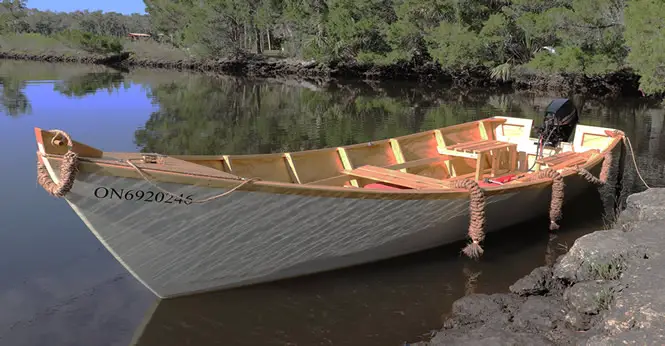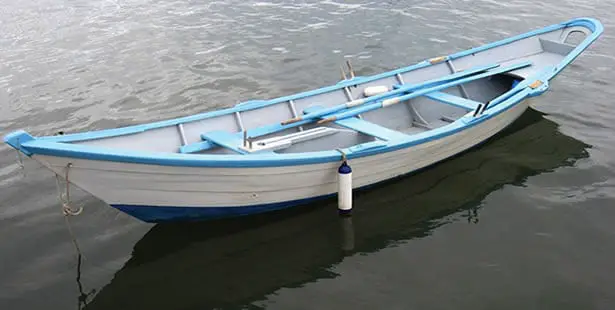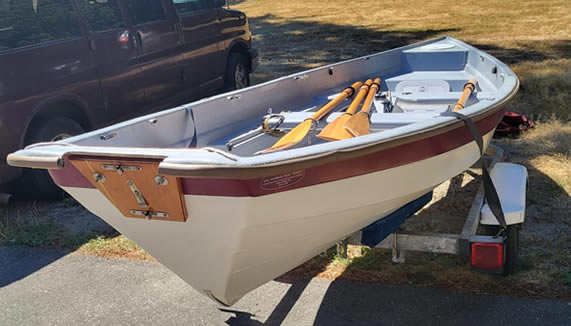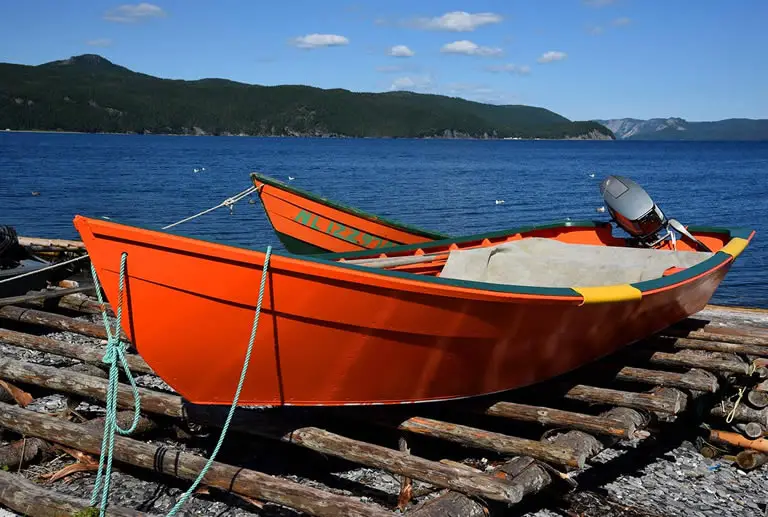When it comes to small boats, a dory may not be the most common sight on the water but they are out there. Even when skiffs, Jon boats, kayaks and canoes litter the waterways it is not totally uncommon to see a dory floating by.
Contents
The Dory Boat
What is a dory boat?
A dory is a small, shallow draft, flat bottom vessel with narrow transom and no keel.
Traditional dories were rowboats that were launched from a larger craft in ocean bays and used mostly as fishing vessels.
They were designed with a flat bottom to make them easier to stack on the mother ship however this caused problems at sea.

Modern dories can be powered by sail, oars or outboard motor.
The most common dories used on inland waters are drift boats.
A quick history of the dory boat
The true history of the dory has been lost through the centuries but thanks to the research of John Gardner, as outlined in his published work The Dory Book, we do know that the first really detailed account of a dory was back in 1719.
Although the dory seemed to be used extensively throughout Europe there is not much resources telling us about their historical uses outside of America.
In North American dories were built in Long Island in the USA and Nova Scotia in Canada and they were used as fishing boats across New England and Newfoundland as early as the 1700’s.
The problem with identifying the earliest history of the dory is the fact that most dories were adapted for the local conditions in which they were used. So dory boats varied from place to place.
As there is no one dory design, and because boats could have local names, tracing the earliest uses of this boat is difficult.
The most well-known type of dory in America is The Grand Banks dory, named after the Grand Banks of Newfoundland where the boat was very popular and a common sight on the waters.
The Grand Banks dory has straight sides (like a flat bottom kayak), a straight bow, flat bottom, and narrow tombstone-shaped transom.
These boats were were used extensively on the north eastern coast of America. They were very successful fishing vessels.
Also, because of their unique hull design, and because they were very light, this meant they could be stacked one on top of another when not in use.
These space-saving and weight-saving features made them a popular choice for carrying on larger vessels where space is at a premium
Grand Banks dories were often kept onboard larger fishing schooners from which they were launched to catch the cod on the Grand Banks.
These dories became popular because their use eliminated the need to use hand-lines on the main ship for catching fish – which was more difficult and time consuming.
When the conditions were optimal, dories would be launched early each day with either one or two crew members.
Throughout the day the dory would return to the main ship to offload its catch.
The offshore popularity and success of the Grand Banks dory, in addition to its durability, cheap construction cost and ease of storage, led to a growth in popularity for inland waterway use as well.
Dories are such a versatile vessel that they soon morphed from a simple fishing vessel into lifeboats, sailboats, motorboats and recreational watercraft.
Why the traditional dory had a flat bottom
Traditional dories were wooden boats that were very cheap to make in comparison to other vessels.
They are still cheap to make today from cost-effective plywood which makes them popular as a home-build project for amateur boat builders.
Although most flat-bottomed boats are far from ideal for ocean use, the traditional dory was somewhat suited to ocean conditions.
Its narrow “tombstone” transom and pointed bow allowed the boat to ride well on waves.
However, due to the flat bottom hull design a traditional dory was very unstable and difficult to handle.
It wasn’t until weight was added, from a fishing catch, that the boat became much more stable and easier to handle.
This often acted as an incentive to catch more fish, and catch it quickly, when a dory was used for commercial purposes; many fishermen lost their lives due to the instability of their dories.
Dories only had flat bottoms to make them easier to store on the schooner that carried them.
Ideally dory boats should have had a v-hull bottom to give them better stability in ocean waters.
Though all dories have the same basic design characteristics mentioned above, dory boats tend to vary a lot in shape and functionality depending on locality.
A dory in one area may look very different from a dory in a different area.
Dory designs slowly changed over time and they changed in different ways in different areas as local fishermen made alterations to the boat better to make it better suited to their local waters.
Although traditional dories have straight sides, a flat bottom and tombstone-shaped transom some modern dories are only remotely related to their ancestors.

Some of these “dories” have curved sides with only a very slight fat bottom, or no flat bottom at all, and a transom that has is pointed, or widened.
This was probably incorporated into the boat design in an effort to stabilize the vessel and allow it to be used in more challenging waters.
Modern dories are both commercial & homebuilt
Modern dories usually come in the form of commercial fishing vessels or recreational motorboats.
However, home-built dories are becoming an ever more common sight on the water these days.
Amateur boat builders will often take on a flat-bottom boat building project based on a Jon boat (as we demonstrated how to build here). There are a growing number of boat building enthusiasts who prefer the design of the dory for their DIY boat though.
If you’d like to try your hand at dory boat building then you’re in luck.
For less than 5 bucks you can buy the book How to Build the Gloucester Light Dory, by Harold Payson, which is an excellent guide to building an excellent dory.
Be aware though that the small print on the plans in the book can be hard to see because the plans had to be printed small to fit into the book.
If you have trouble seeing the drawings properly you can get blown-up plans, with all the small print clearly visible, for just $40 from instant boat plans.
It’s worth the extra investment but if you can only get one, get the book!
Due to the unstable nature of traditional dories modern design interpretations incorporate characteristics that greatly improve stability but that are still not really suitable for ocean use.
You shouldn’t use normal dory in the sea for the same reasons we don’t recommend using a Jon boat in the ocean.
In addition to this the weight of a dory can cause problems for you in open water.
Although traditional dories have always been lightweight these days dories are even lighter than their predecessors.
This leaves them at the mercy of strong winds and choppy waters.
Because they are so lightweight their use in challenging waters and strong wind can be problematic as they can be blown around easily.
Most modern dories are almost always used on inland calm waters, or along the shoreline, as fishing vessels or for recreational use though there are exceptions.
As an inland boat used in calm conditions a dory is an excellent alternative to a Jon boat or canoe.
Modern dories can be powered by oars, sail and can be fitted with an outboard motor. Some dories are fitted with inboard engines and remote steering.
If you need to know the difference between an outboard engine and an inboard engine read this.
What the dory is used for
Modern dories are mostly used on calm inland waterways though not always.
There are still seaworthy dories about but the majority of these boats are used for recreational purposes and mostly inland.
Modern river dories are known as drift boats and have some deign modifications. We covered drift boats in detail here.
Dories have a shallow draft which means that can be used in shallow waters. They are excellent vessels for shallow water fishing and hunting.
Anything that you can do in a Jon boat, from boat camping to shallow water fishing and even duck hunting, can be done in a dory.
Some modern recreational motorboats, like the Orkney Dory 424, are a very modern take on the traditional dory and are fitted with high speed outboard motors.
There are also modern fishing dories, like those from C Dory, those these boats more resemble small fishing trawlers than traditional dories.
Most non-commercial dories that you will see on the water will be small vessels either powered by an outboard trolling motor or fitted with oars.
They are excellent fishing boats and family recreational boats.
Are modern dories seaworthy?
Traditional dories were seaworthy craft though they were often unstable, difficult to handle and dangerous to be in – at least until some weight was added to them.
However, due to their lightweight nature they could be at the mercy of both wind and waves. Modern dories have similar problems.
In fact, modern dories being lighter than traditional ones, are even more at mercy of the wind.

Their flat bottom hull, which makes them extremely stable on calm water, makes them uncomfortable to ride in on waves and more susceptible to taking on water in challenging conditions.
It can be difficult to buy or find boat building plans for a dory that is seaworthy.
Even if you were to build a dory based on the traditional design, of say a Grand Banks dory, you would end up with a boat that seaworthy but risky to use.
As already mentioned, it wasn’t uncommon for fishermen to go overboard and drown when fishing from a dory.
Modern dories are more suited to calm inland waters.
As a rule-of-thumb we can say that – anywhere a mod-v Jon boat can be used, a flat-bottom dory can be used also.
The difference between a drift boats and a dory
Drift boats have evolved from ocean dories and are used on inland waterways for river running and fishing. Some are even fitted with motors.
These amazing boats have many of the characteristics of the dory boat but with several unique hull modifications.
Due to their unique uses drift boats are often bought instead of dory boats.
You can read more about the differences between these two similar boats in our article Drift Boat vs Dory.

